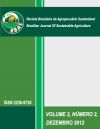ANALYSES OF LOSSES OF STEM, LEAVES AND FRUITS ON FRESH VEGETABLES ON GROSS TRADE IN AREIA (PB)
DOI:
https://doi.org/10.21206/rbas.v2i2.170Abstract
It was conducted a survey of the losses of onion, lettuce, cilantro, cabbage, eggplant, cucumber and okra at fresh market in Areia (PB) in order to provide information that may assist the sector specific actions to reduce losses of vegetables fresh retail site and increase profitability in business activity. It was used a questionnaire consisting of 40 questions, which included socio-economic aspects, production, commercialization and marketing of storage. Respondents were divided into three groups: group I fairground producers of vegetables that sells directly in free market, group II consists of fairground not producers of vegetables, but that the purchase of third parties weekly and group III consists of traders owners of retail chains. It was found that the sprouting of onion bulbs; mass loss, color and texture in lettuce, cilantro and kale; ripening and loss of color and texture in eggplant, cucumber and okra; friction and mechanical injuries caused by damage insects and pathogens were responsible for the most significant losses in these vegetables. It is important to adopt good manufacturing practices, handling, hygiene, packaging and exhibition of vegetables after harvest in order to minimize losses in the marketing of vegetables in Areia (PB). Losses pre and post-harvest by offering variation in market behavior, generate serious economic and social consequences.Downloads
Download data is not yet available.
Downloads
Published
2012-12-01
How to Cite
Edmilson Igor Bernardo Almeida, Hélder Horácio de Lucena, Wellington Souto Ribeiro, Márcia Roseane Targino de Oliveira, & José Alves Barbosa. (2012). ANALYSES OF LOSSES OF STEM, LEAVES AND FRUITS ON FRESH VEGETABLES ON GROSS TRADE IN AREIA (PB). Brazilian Journal of Sustainable Agriculture, 2(2). https://doi.org/10.21206/rbas.v2i2.170
Issue
Section
Artigos
License
1. Proposta de Política para Periódicos de Acesso Livre
Autores que publicam nesta revista concordam com os seguintes termos:
Autores mantém os direitos autorais e concedem à revista o direito de primeira publicação, com o trabalho simultaneamente licenciado sob a Licença Creative Commons Attribution que permite o compartilhamento do trabalho com reconhecimento da autoria e publicação inicial nesta revista.











